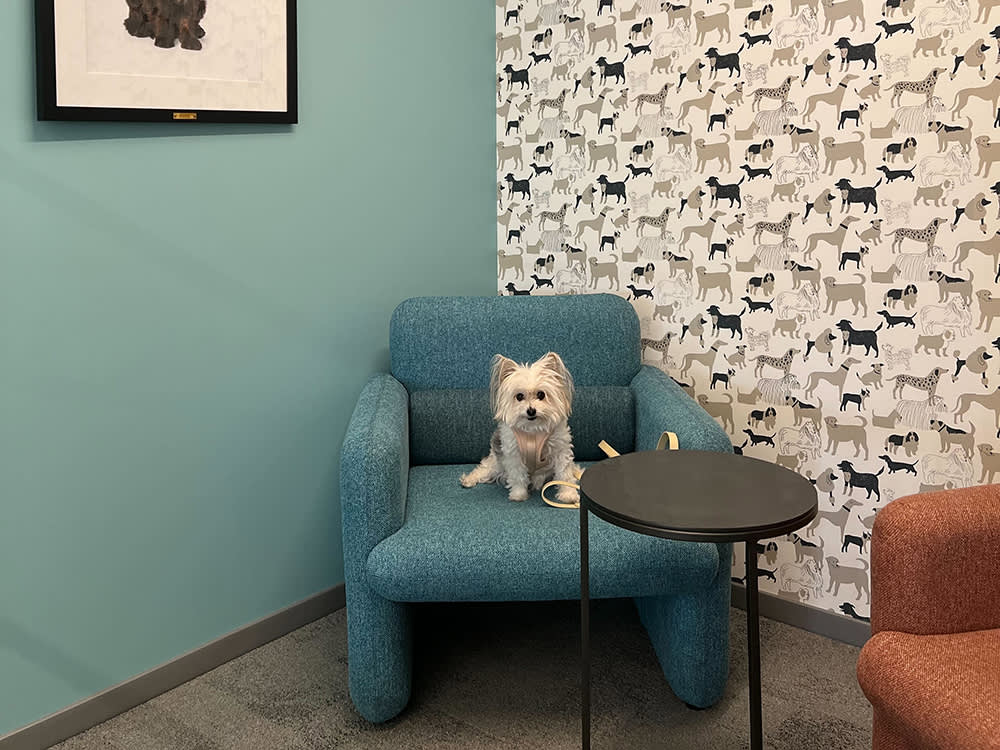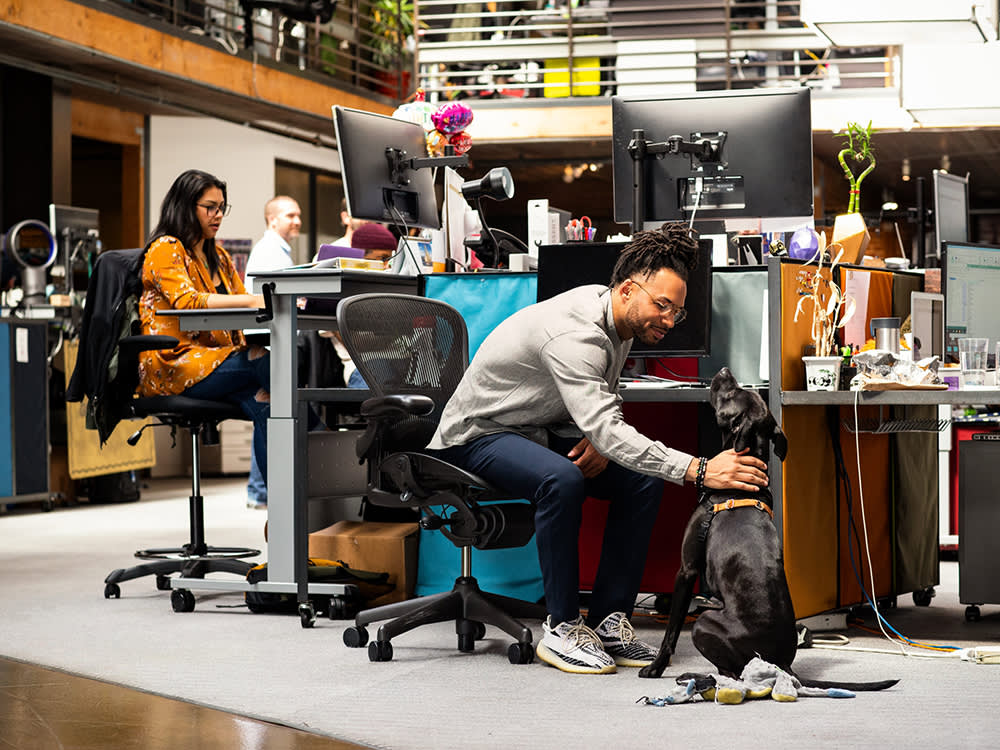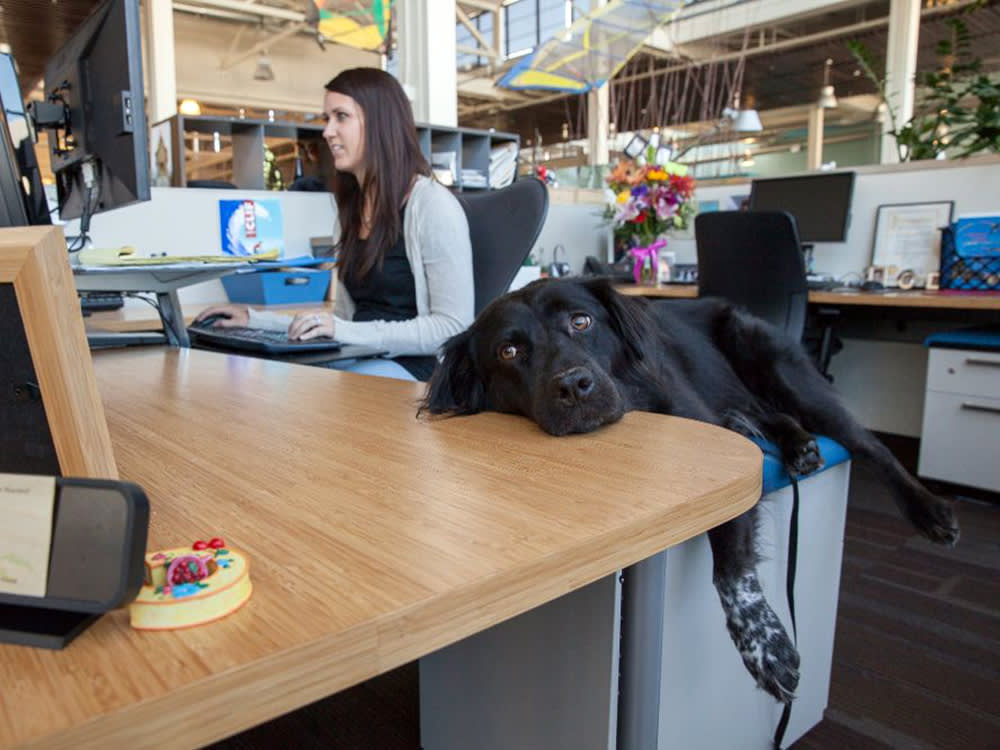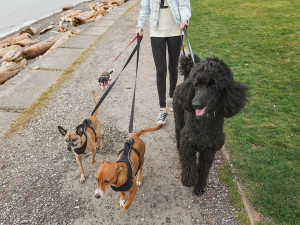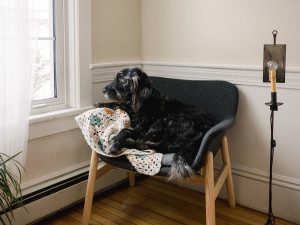15 Best Dog-Friendly Companies to Work For
In 2023, the only job worth having is one that lets you bring your dog to the office.
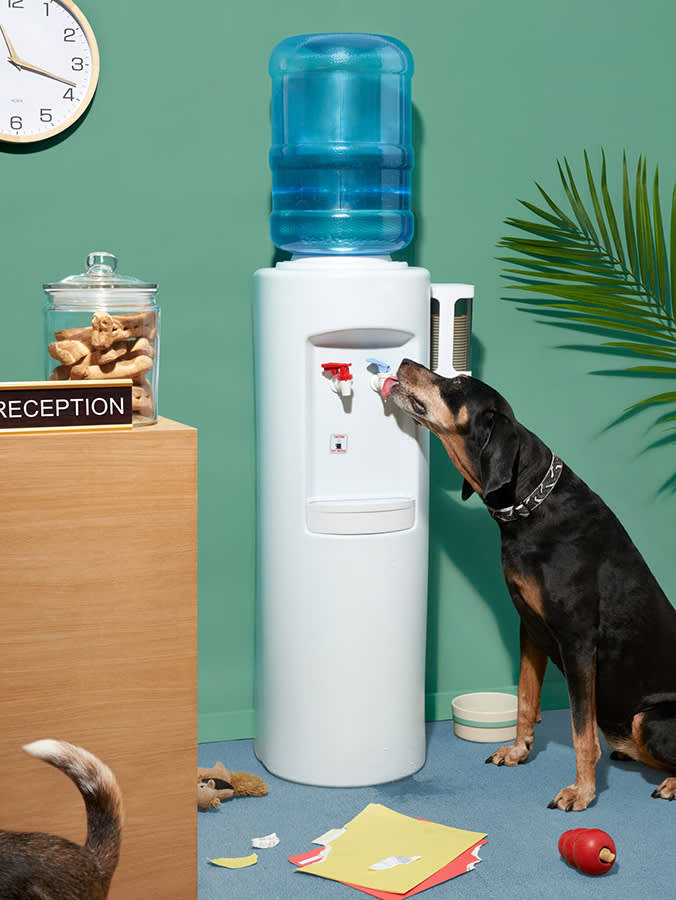
share article

Your pet wants you to read our newsletter. (Then give them a treat.)
We know: The worst part of the work day is the possibility of leaving the dog behind. While we’re busy bringing home the bacon (and bacon-flavored treats), who’s going to shower our pups with attention? Without us there to remind them every five minutes, how can we be sure they’ll remember what good doggies they are? It’s impossible not to worry — plus, having a dog around makes everything better, including spreadsheets.
Luckily, some companies are starting to understand the positive impact a canine presence can have. And they don’t just let dogs nap by your desk; they also offer luxurious perks, including doggy daycare, grooming, and treats. Below is a list of our favorite dog-friendly workplaces.
Etsy
HQ: Brooklyn, New York
What isn’t there to love about the small-business-empowering marketplace where you can buy anything from a Bichon candleopens in a new tab to a custom-made pillowopens in a new tab shaped like your pup? As it turns out, it’s just as fun for a dog parent to work at Etsy as it is to browse their pet-themed gifts. Etsy helped lead the way when it comes to dog-friendly work environments; their office has welcomed dogs since 2005. They’re in a hybrid work model now, so whether employees are at home or in the dog paradise of Etsy’s Dumbo office, they can cozy up with their pets.
Urban Outfitters
HQ: Philadelphia, Pennsylvania
The always-on-trend retailer isn’t just a gem for dog-loving shoppers (where else can you find the perfect puppy pufferopens in a new tab?) — it’s also a dog-loving employees’ dream. The Urban Outfitters headquarters welcome dogs to the office and includes dog parks on-site. If you want to see some of these lucky dogs yourself, a page on their siteopens in a new tab is dedicated to employees’ pups. Non-employees benefit from Urban’s pooch-friendly policies, too: Leashed dogs are welcome to join shoppers in Urban Outfitters stores.
Airbnb
HQ: San Francisco, California
If you’re the kind of person who exclusively searches the “pet friendlyopens in a new tab” Airbnb tag because you can’t bear to be apart from your four-legged bestie, Airbnb employees relate. Just as you treat your dog as you would any roommate (or, OK, maybe a little better — your dog can’t wash their own dishes, after all), Airbnb treats dogs as valued employees: Over at Airbnbopens in a new tab’s dog-friendly workplace, dogs are given their own employee badges to scan, plus in-office snacks.
HQ: Mountain View, California
Googleopens in a new tab has been a dog-friendly company since 1999, and they couldn’t make their dog-obsession more explicit: The company’s actual Code of Conductopens in a new tab reads, “Google’s affection for our canine friends is an integral facet of our corporate culture. We like cats, but we’re a dog company, so as a general rule we feel cats visiting our offices would be fairly stressed out.” (Cat people, stand down.) At Google’s Mountain View offices, employees and their pups have access to a dog park called The Doogleplex, and all can participate in a dog group and message board called the Dooglers.
Kinship
HQ: Manhattan, New York; San Francisco, California; Portland, Oregon
It makes sense that The Wildest’s parent company, which has the goal to “help everyone pet parent like a pro” would start with their employees. Benefits include new pet-parent paid leave, a pet stipend, flex days for vet visits and training, and bereavement leave — plus dog-friendly offices in San Francisco, Portland, and NYC. We aren’t biased at all, we swear.
Huge
HQ: Brooklyn, New York
The creative growth acceleration company was established out of its founder’s apartment in 1999 and quickly garnered big-name clients, such as Target, Pepsi, JetBlue, CNN, Samsung, and Hulu. It’s now far from its apartment-dwelling roots, with 1,500 employees and offices in nine cities. Its headquarters in Dumbo is the stuff of Gen-Z dreams: There’s a ping-pong table, beer fridge, free snacks, and conference rooms named after celebrities like Jay-Z — not to mention, the companionship of pups with titleopens in a new tabs like “Cuteness coordinator” and “Nap-time advocate.” The office is also conveniently close to a dog park, and employees often gather after hours to let their hard-working pups blow off some steam.
Hinge
HQ: Manhattan, New York
If your Hinge profile says “must love dogs,” the app agrees. The “designed to be deleted app” prioritizes their employees’ pets: The Greenwich Village Hinge offices are dog-friendly, and the company offers pet insurance. Fun fact: Hinge also offers employees a monthly $200 stipend to use on a date — that amount of cash can buy a lot of dog treats.
Twitch
HQ: San Francisco, California
The live-streaming entertainment website has exploded in popularity in recent years and shows no sign of slowing down. Pups might not be able to host their own stream yet (we’re waiting), but they can hang out at the Twitch headquarters, where they’re given their own employee badge and pet insurance. Twitch also partners opens in a new tabwith zoos, aquariums, and non-profits to raise awareness for their causes through streaming.
Subaru
HQ: Camden, New Jersey
Where there’s a Subaru auto show, there’s usually a dog nearby: Subaru partners with animal shelters to raise awareness for dogs in need of adoption. Through their Subaru Loves Pets opens in a new tabinitiative, Subaru hosts adoption events and raises money for pets in need; they have donated over $42 million to rescue organizations and helped over 100,000 dogs find homes. As the president of the LA Auto Show told Triple Punditopens in a new tab, “From our standpoint it’s really cool, because the Subaru booth is right underneath our show office. I can look down on the booth all day long and see the dogs coming and going.”
Refinery29
HQ: Manhattan, New York
Refinery29 was founded in 2005 by two pop-culture obsessed friends; it has since grown into a publication dedicated to giving young women a voice, the tools to be independent, and a space to discover their personal style. Employees at Refinery29 are encouraged to bring their pups to work — you can meet some of the pets behind the site in a post aptly titled “Meet: The Great Pets Behind Refinery29’s Humans.opens in a new tab” (You’ll want to click the link — some name highlights include Latte “Meghan Markle” Starbucks, Sir Frederick of Cambridge, and Cauliflower.)
Tito’s Handmade Vodka
HQ: Austin, Texas
Tito’s is another company that has opened its doors to dogs — who they call their “co-woofers” — from the beginning. Tito’s is also committed to doing good by dogs outside the office: They regularly partner with organizations to transport dogs in dangerous situations to safety, and they have a national fundraiser for low-cost spay-neuter surgery called Vodka For Dog Peopleopens in a new tab.
Microsoft
HQ: Redmond, Washington
The company behind Powerpoint, Word, Xbox, and Minecraft is bound to be an exciting place for movers and shakers to work (though you probably can’t get away with lying on your résumé about how well you really know Excel). The appeal goes doubly for dog parents: Microsoft offices are pet-friendly oases, and the company offers pet insurance to pet-parent employees.
Humane Society of the United States
HQ: Washington, D.C.
The fact that the HSUS does good by animals is undeniable, so it makes sense that they look out for their employees’ pets, too. Not only does the HSUS allow employees to bring their dog with them to work each day, but they offer a dedicated doggy play yard, low-cost pet insurance, pet sitting, discounts on pet-related services, and on-site dog training.
Clif Bar & Company
HQ: Emeryville, California
Clif Baropens in a new tab has been welcoming dogs since they started operations in 1992. At their spacious headquarters, Clif offers employees and their dogs a large off-leash area and a pet insurance discount — all under the supervision of their Chief Dog Officer, a pup named Gus. Clif isn’t just looking out for their employees’ dogs, either; they spread the love by providing unlimited paid time off to volunteer for animal causes.
Ben & Jerry’s
HQ: South Burlington, Vermont
It sounds like a fairytale that the company behind Phish Food ice cream is also one of the most dog-friendly offices in the country, but some things just make sense. The ice cream manufacturer refers to their dog crew as their “K9 to 5ers,” and they’re greeted each morning with treats and pets before starting their day as valued members of the team. We’re guessing the K9 to 5ers are the guys behind Ben & Jerry’s Doggie Dessertsopens in a new tab.
How Dogs Help
A study at Central Michigan University found that the mere presence of a dog in the office could help make people collaborate more effectively. The researchers also showed that the staff who worked with a dog gave all their teammates higher scores for trust and team cohesion than those who worked in dog-free groups.
Another study, conducted by an aptly named investigator, Randolph Barker, PhD, professor of the Virginia Commonwealth University School of Business, confirms that dogs are the greatest destressors for both dog parents and the dogless employees in their office, as well as collaborative “assistants.” They found that dogs do buffer the impact of stress during the workday for their people and make the job more satisfying for those with whom they come into contact. “Dogs in the workplace can make a positive difference,” Barker said. He also concluded that “a pet presence may serve as a low-cost, wellness intervention readily available to many organizations and may enhance organizational satisfaction and perceptions of support. Of course, it is important to have policies in place to ensure only friendly, clean, and well-behaved pets are present in the workplace.”

Cameron Woo
Cameron Woo was co-founder, publisher, and art director of The Bark magazine.
Related articles
![Dog chewing spiked orange toy at home]() opens in a new tab
opens in a new tab6 Ways to Keep Your Dog Entertained While You’re At Work
Don’t hit pause on your pet’s playtime – these solo activities will help 9-5 fly by for them.
![dog walker walking 4 dogs by the beach]() opens in a new tab
opens in a new tabThe Race to Find a Back-to-Work Dog Walker
Who will love your dog like their own (for 30 minutes per day).
![Woman sitting on the floor holding a white mixed breed dog in a relaxed living room setting]() opens in a new tab
opens in a new tabHow to Choose a Trustworthy Dog Sitter
Leave your pup in the best possible hands with these tips.
![A dog sitting in a chair staring out a window.]() opens in a new tab
opens in a new tabCeleb Dog Trainer Nicole Ellis on Getting Your Dog Used to Your Office Return
It’s 2023, and the office is calling. How can our dogs cope?


